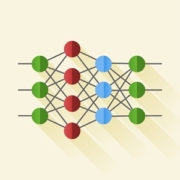آموزش شبکه هاي عصبی توابع پایه شعاعی توسط الگوریتم بهینه سازي حرکت یونها به منظور شناسایی هدف سوناري واقعی از هدف کاذب
چکیده
شبکه هاي عصبی توابع پایه شعاعی (RBF) یکی از پرکاربردترین شبکه هاي عصبی در تشخیص و کلاس بندي اهداف سوناري میباشند. با توجه به استفاده از روش هاي بازگشتی و گرادیان نزولی براي آموزش شبکه هاي ،RBFدقت دسته بندي نامناسب، گیر افتادن در کمینه هاي محلی و سرعت همگرایی پایین از معایب این نوع شبکه میباشد. به منظور غلبه بر این معایب، این مقاله براي آموزش شبکه RBFاز الگوریتم بهینه ساز حرکت یونها (IMO) استفاده میکند. به منظور سنجش عملکرد شبکه طراحی شده با الگوریتم هاي معیار ES ،ACO ،GA ،PSOو PBILاز نظر سرعت همگرایی، دقت کلاس بندي و اجتناب از بهینه محلی مقایسه میشود. نتایج نشان دهنده آن است که شبکه طراحی شده با الگوریتم IMOنسبت به الگوریتم هاي معیار نتایج بهتري را ارائه میکند به صورتی که نسبت به بهترین الگوریتم 2/69درصد دقت بیشتري دارد.
مقدمه
شبکه هاي عصبی RBFیکی از پرکاربردترین ابزار براي محاسبات نرم است. با استفاده از این شبکه ها میتوان مسائل غیرخطی را حل نمود. به طور کلی شبکه هاي عصبی RBFبه منظور دسته بندي الگو، پیشبینی داده و تقریب زدن توابع مورد استفاده قرار میگیرند]3،2،1و .[4صرف نظر از کاربردها، توانایی متمایز شبکه هاي RBFیادگیري است .یادگیري این شبکه ها همانند مغز انسان میتوانند از یک تجربه یا آزمایش یاد بگیرند. این ویژگی (یادگیري) بخش ضروري همه ي شبکه هاي عصبی است که ممکن است به دو نوع تقسیم گردد: یادگیري با نظارت و یادگیري بدون نظارت به طور کلی آموزش شبکه هاي عصبی یک چالش براي مسائل بهینه سازي غیرخطی است. روش هاي زیادي بر پایه ي مشتق گیري براي تعلیم شبکه هاي عصبی RBFشامل گرادیان نزولی ، (GD)4فیلتر کالمن ، (KF) فیلتر کالمن تفکیک شده (DKF5) و پس انتشار (BP) استفاده شده اند. علاوه بر روش هاي مبتنی بر مشتق، روش هاي بدون مشتق گیري، از جمله الگوریتم ژنتیک یادگیري اتوماتیک و تبرید تدریجی در آموزش شبکه هاي RBFاستفاده شده است. هدف نهایی فرآیند یادگیري در شبکه هاي عصبی، پیدا کردن بهترین ترکیب از پارامترهاي شبکه میباشد به طوريکه در آموزش شبکه و نمونه هاي تست، کمترین مقدار خطا را داشته باشیم، که این امر با کاربرد الگوریتم بهینه سازي حرکت یونها 8 (IMO) محقق میشود.
ABSTRACT
Neural Networks Radial base functions (RBFs) are one of the most widely used neural networks in the diagnosis and classification of sonar targets. Regarding the use of recursive methods and descending gradients for training networks, RBFs are poorly categorized, trapping at local minima and low convergence rates are the disadvantages of this type of network. In order to overcome these disadvantages, this paper uses the ion-optimization algorithm (IMO) to train the RBF network. In order to measure the performance of the network designed with ES, ACO, GA, PSO and PBIL benchmark algorithms, comparing the speed of convergence, classification accuracy and local optimal avoidance are compared. The results show that the designed network with the IMO algorithm offers better results than the standard algorithms, which is more accurate than the best algorithm of 69.2%.
INTRODUCTION
RBF Neural Networks is one of the most widely used tools for soft computing. Using these networks can solve nonlinear problems. In general, RBF neural networks are used to categorize, predict, and approximate functions [3,2,1 and 4]. Regardless of applications, the distinct ability of RBF networks is learning. Learning these networks can be the same as the human brain. Learn from an experience or experiment. This feature is an essential part of all neural networks, which can be divided into two types: learning with unattended monitoring and learning. Generally training neural networks is a challenge for nonlinear optimization problems. Various methods based on the derivation of RBF neural network training include descending gradient, (GD) 4 Kalman filter, (KF), Kalman filtered (DKF5) and back propagation (BP) filters. In addition to derivative-based methods, non-derivative methods, such as automatic learning genetics algorithm and gradual refrigeration in RBF network training, have been used. The ultimate goal of the learning process in neural networks is to find the best combination of network parameters in order to minimize the error in network training and test samples, which is achieved by using the ionization optimization algorithm (IMO) algorithm. .
Year: 2017
Publisher : International Conference on Basic Research in Electrical Engineering
By : Mohammad Khooseh, Sajjad Roahkhah, Mohammad Qomi Owili
File Information: Persian Language/ 19 Page / size: 910 KB
سال : 1396
ناشر : کنفرانس بین المللی تحقیقات بنیادین در مهندسی برق
کاری از : محمد خویشه ، سجاد رواخواه ، محمد قمی اویلی
اطلاعات فایل : زبان فارسی / 19 صفحه / حجم : KB 910

![آموزش شبکه هاي عصبی توابع پایه شعاعی توسط الگوریتم بهینه سازي حرکت یونها به منظور شناسایی هدف سوناري واقعی از هدف کاذب[taliem.ir]](https://taliem.ir/wp-content/uploads/آموزش-شبکه-هاي-عصبی-توابع-پایه-شعاعی-توسط-الگوریتم-بهینه-سازي-حرکت-یونها-به-منظور-شناسایی-هدف-سوناري-واقعی-از-هدف-کاذبtaliem.ir_.jpg)

![آنالیز فرایند ازدیاد برداشت از منابع نفت با تزریق آب هوشمند[taliem.ir] آنالیز فرایند ازدیاد برداشت از منابع نفت با تزریق آب هوشمند[taliem.ir]](https://taliem.ir/wp-content/uploads/آنالیز-فرایند-ازدیاد-برداشت-از-منابع-نفت-با-تزریق-آب-هوشمندtaliem.ir_.jpg)

![بررسی قراردادها و شيوه های اعطای تسهيلات در بانکداری اسلامی و رابطه آنها با کاهش فقر در جامعه[taliem.ir]](https://taliem.ir/wp-content/uploads/بررسی-قراردادها-و-شيوه-های-اعطای-تسهيلات-در-بانکداری-اسلامی-و-رابطه-آنها-با-کاهش-فقر-در-جامعهtaliem.ir_-150x150.jpg)
![Antimicrobial Properties of Socks Protected[taliem.ir]](https://taliem.ir/wp-content/uploads/Antimicrobial-Properties-of-Socks-Protectedtaliem.ir_-150x150.jpg)
دیدگاه خود را ثبت کنید
تمایل دارید در گفتگو شرکت کنید؟نظری بدهید!